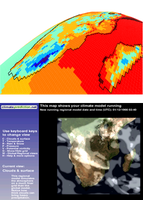Penn State provides processing power to new international “weather-at-home" experiment
University Park, PA (November 19, 2010) -- A large, new international research project launched this week by climateprediction.net, the world’s largest climate forecasting experiment, and the UK Met Office Hadley Centre aims to narrow the uncertainty of the effects of global climate change on regional and local weather events, both now and in the future.
The new project will allow anyone with a computer and internet access to take part and help scientists understand how global warming may be affecting damaging--or beneficial--weather events around the world.
Since 2003, climatepredication.net’s vast collection of donated computing resources have run UK Met Office models and explored the uncertainties in global climate predictions in unprecedented depth. Now, this new experiment will use those results to produce more detailed models simulating the changing weather in, initially, three target regions: Europe, the Western United States and Southern Africa.
Penn State Meteorology’s role in this project is significant in that it serves as one of the institutions in the United States that will process the experiment data. An Intel, Linux-based server with seventeen terabyte of storage has just been deployed at the Penn State, Department of Meteorology under the direction of climate scientist, Prof. Chris E. Forest. Forest has also just received funding from DOE to establish an additional server at Penn State, which he hopes to have processing data by spring 2011.
Results from the three different regions will be used directly by professional scientists specializing in the climates of those regions. The European region will be analyzed by the Met Office Hadley Centre and Oxford, Edinburgh and Leeds Universities; Southern Africa by the University of Cape Town; and the Western United States by Oregon State University. Results will also be made available to scientists interested in climate impacts in the various regions.
“Climate models are not crystal balls, but they can be useful tools provided people understand the uncertainties,” explains Sue Rosier, leader of this climateeducation.net initiative. “Anyone participating in the experiment could use these information resources to learn about how climate simulation works, and potential users can explore how - and how not - to use our results in planning how to adapt to climate change.”
For more information on the weather-at-home experiment, visit:
http://www.guardian.co.uk/environment/2010/nov/17/weatherathome-climate-change-weather-project?intcmp=239 and http://climateprediction.net/weatherathome

